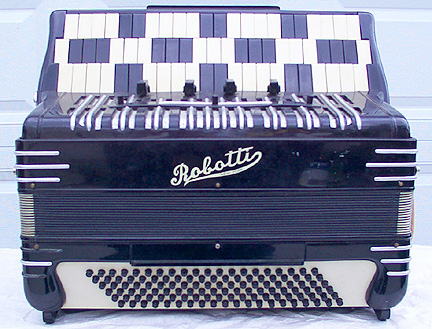Thank-you for your eMail about the "Reuther System".
This isn't the Hayden System; the semitone intervals between
the notes are 2, 1, 1; whereas the Hayden system has 7, 2,
5. It is probably one of the earliest self-transposing
systems to be invented; being first patented in 1811 (Pat.
No. 3404) by Trotter for the Piano or Organ: there are no
known instruments deriving from Trotter.
It was later reinvented but in a 6 row form by Janko later in
the nineteenth century (1885 Pat. No. 536), for the Piano.
Quite a number of Janko instruments were made and several
still exist; Rubenstein is said to have tried it and very
much liked it; however it was the piano teachers who managed
to kill off the system, as they made most of their money not
from teaching virtuosos, but by continual repeat lessons to
ordinary amateur players just to learn to play in more and
more difficult keys.
The system was then reinvented for the accordion around the
beginning of the last century under the name "Uniform
System", at a similar time as the " Continental Chromatic
Accordion System" (with intervals 3, 1, 2.). The advantages
of a much narrower octave on the "C.C.", seems to have given
it the edge over the "U.S." and that is the one that has
become popular. The Uniform System may be ordered
from several Italian accordion makers on a one-off basis.
Self-transposing systems work by having a triangle of the
keyboard touches with the musical interval at constant
recurring form. If we take the largest sensible musical
interval to be an octave (12 semitones), it might be assumed
that there could be as many as 12!/3! (factorial 12 divided
by 6) possible keyboards. However on closer
mathematical inspection we find that this is not the
case. Look at it another way. Of the 3 musical
intervals in semitones, there is a greatest interval G (any
whole number from 2 to 12) and the least interval L
(obviously G & L cannot be the same number); the other
interval is the difference between the two i.e. G - L, which
we will call D. D is obviously less than G but it might
be the same as L as in the case of the "Uniform System" which
we were looking at. The number of possible keyboards is
also reduced by a further couple of factors. If G is an even
number then L cannot be an even number because D would also
be even, and this would only generate the notes of a whole
tone scale; and further if G is divisible by 3, L cannot be
divisible by 3 or D would be divisible by 3 thereby only
generating only the notes of a diminished seventh chord.
So the only possible fundamentally different self-transposing
keyboards are as follows in the order G, L, D:- (1) 2, 1,
1. (2) 3, 1, 2. (3) 4, 1, 3. (4) 5, 1, 4. (5) 5,
2, 3. (6) 6, 1, 5. (7) 7, 1, 6. (8) 7, 2, 5. (9) 7, 3, 4.
Higher intervals than 7 do not generate useful keyboards, I
won't list all these, with the notable exception of (24) 12,
5, 7. And of course simply a single run of semitones which I
shall call - (0) 1.
Some people see the "square form" of keyboard as different
from the ones that have set intervals in triangles, however I
see this as a special case with right angled triangles, where
one set of intervals is about to form into another. Take for
example the Pitt-Taylor 1922 Pat.No. 208274 keyboard.
with semitones along the rows of notes and half octaves above
them, i.e. a rows of notes:
F F# G G# A Bb
B C C# D Eb E
Looked at one way is G,L,D. : 6, 1, (5). or the other
(7), 1, 6.
In addition mirror images and keyboards which are turned
upside down are not fundamentally different. A good
example of this is the B continentinal chromatic keyboard,
which is the mirror image of the C continental chromatic
keyboard.
I hadn't come across this system under that name before,
however I have met it on Accordions before where it is
usually called the "Uniform System". I have turned up
an article by Albert Delroy from "Accordion Times" about 20
years ago, (regret I only have a photocopy of the article not
the whole magazine to date it exactly). He writes that
it was invented in that form for the Accordion by John H.
Reuther of New York. He also mentions that it already
existed as the "Austrian" system but with round buttons. The
Scottish Accordionist, the late Jimmy Blair, was an exponent
of this system.
Out of the mathematically possible systems, 9 have been
patented, proposed, or made; including one by Wheatstone. The
Wheatstone patent is 1844 Pat. No. 10041: see figures 7 &
8 of that patent. This is G.L.D. 5, 1, 4. GLD 12,
5, 7 will be found as Wesley 2002 (US Patent # 6501011)
although I did mention the possibility of this as a squashed
form of mine if you read the text very carefully. And
finally, there is a free bass keyboard for the accordion
Ronald Merrett, 1956 pat. no. 856926, which is GLD 7,
4, 3.

